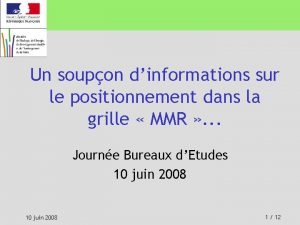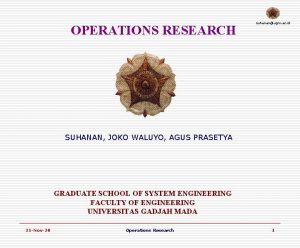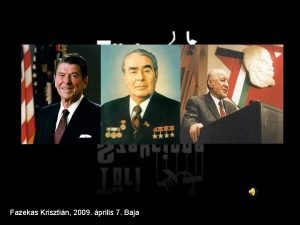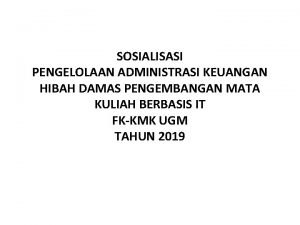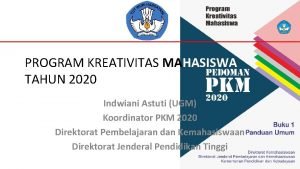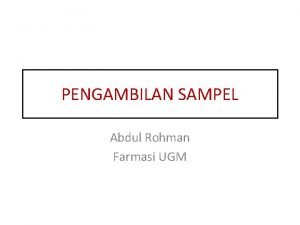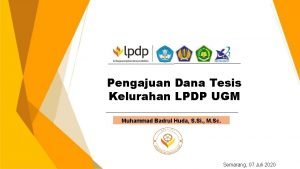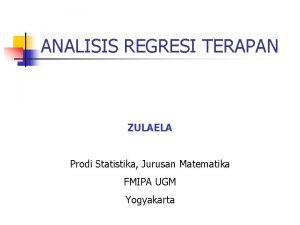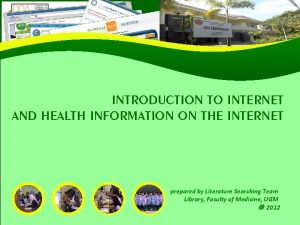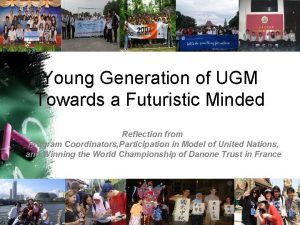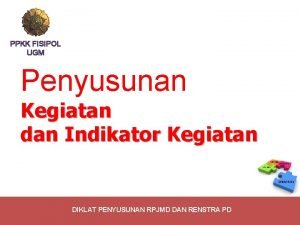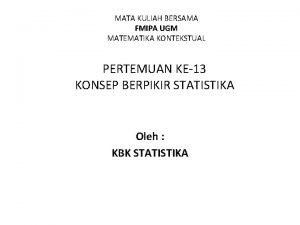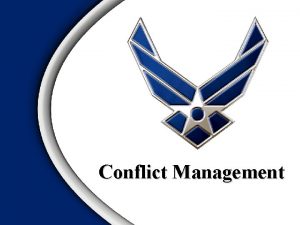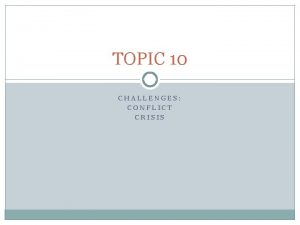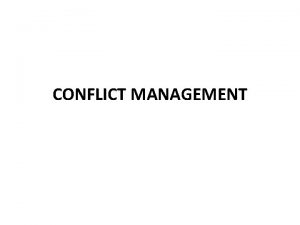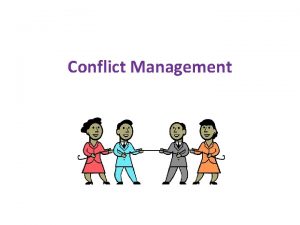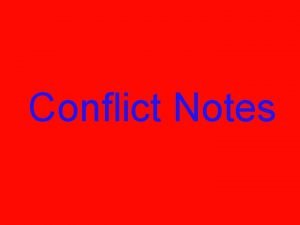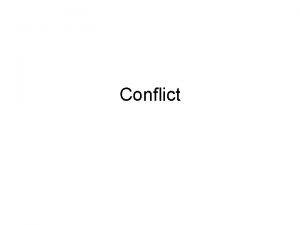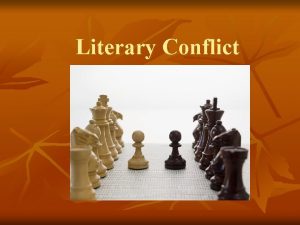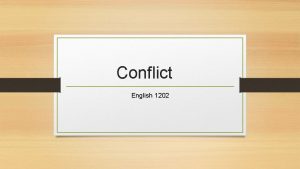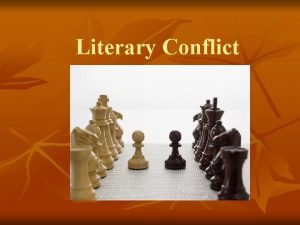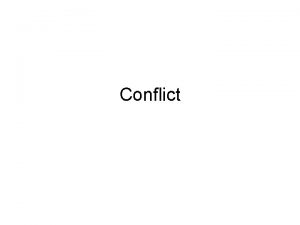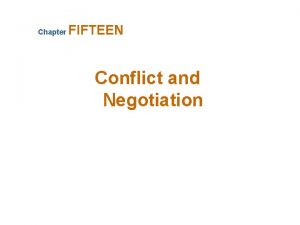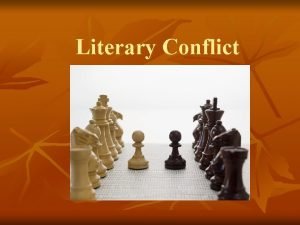Welcome MMR UGM 2019 CONFLICT MANAGEMENT Conflict management





















- Slides: 21

Welcome MMR - UGM 2019

CONFLICT MANAGEMENT

• • • Conflict management is an extremely important managerial skill Research show that managers spend about 20% of their time dealing with conflict. Research also show that the most successful managers devote half again as much time to managing conflict as do less successful managers.

Def: One party perceives its interest are being opposed or set back by another party (a process). Atau situasi dimana terjadi pertentangan perasaan, pendapat, atau kepentingan. Biasanya disertai, ketidaksepakatan namun ketidaksepakatan belum tentu konflik.

KONFLIK PERTENTANGAN PERASAAN, PENDAPAT & KEPENTINGAN Individu Antar Individu Emosional Antar kelompok Subtantif Masalah Utama Antar Organisasi

Fig. The Relationship between Conflict Intensity and Outcomes Positive Outcomes Neutral Negative Low Moderate Intensity High

Antecedents of Conflict 1. 2. 3. 4. 5. 6. 7. Incompatible personalities or value systems. Overlapping or unclear job boundaries. Competition for limited resources. Interdepartment/intergroup competition. Inadequate communication. Interdependent task. Unclear and unreasonable policies, standards, or rules.

Level of Conflict 1. 2. 3. 4. 5. Intrapersonal conflict (happen entirely within the individual) Interpersonal conflict (conflict between two people). Intragroup conflict (exist when there is conflict within the group of an interpersonal nature). Intergroup conflict (when two or more groups are involved in a conflict situation). Interorganizational conflict (where two or more organization are involved in conflict).

Types of Conflict Issues 1. 2. Substantive issues (disagreement over policies & practices, konflik krn keterbatasan sumberdaya dan atas peran dan tanggung jawab). Emotional issues (negative feelings between people such as rejection, resentment, anger & distrust).

Sources of Conflict 1. 2. 3. 4. 5. 6. Conflict over resources Ambiguous jurisdictions Role conflict Communication barriers Dependence of one party Domination

Fig. Conflict Intensity Scales Intense conflict Actual conflict Desired conflict No conflict Intense conflict Needs resolution Desired conflict Actual conflict No conflict Needs simulation

Fig. Potential Outcomes From Conflict Stimulates interest and excitement Brings important issues to surface for problem solving Provides outlets for aggression Leads to increase group cohesiveness Help balance conflict goals May result in better decisions Provides emphasis for diverse projects Potential functional outcomes Conflict Potential dysfunctional outcomes Distorts communication and receptions Results in emotional upheaval May create negative feelings May result in isolation or withdrawal Causes job stress Can reduce job satisfaction Can cause loss of empathy between people

Stimulating Conflict (Functional) 1. 2. 3. Programmed Conflict (encourages different opinions without protecting management’s personal feeling). Devil’s advocacy ( assigning someone the role of critic. Dialectic method (fostering a debate of opposing viewpoints to better understand an issue)

Managing Conflict (dysfunctional) 1. 2. 3. 4. 5. Integrating (Problem solving) Obliging (Smoothing) Dominating (Forcing) Avoiding Compromising

Fig. Five Conflict-Handling Styles High Integrating Low Obliging Compromise Avoiding Concern for others Dominating Avoiding High Low Concern for self

Desired Conflict Outcomes 1. 2. 3. Agreement Stronger relationship Learning

Managerial Application of Conflict 1. 2. 3. 4. 5. Be prepared for conflict episode Take action to avoid undesirable conflicts When conflict is functional, encourage it Use the appropriate conflict resolution strategy Recognized the benefits of third parties

Pengeloalaan Konflik 1. 2. 3. Menstimulasi konflik Mengurangi atau menekan konflik Menyelesaikan konflik

Metode Untuk Stimulasi Konflik 1. 2. 3. 4. 5. Memasukkan orang baru Bertindak bertentangan dengan apa yang umum berlaku Restrukturisasi organisasi Merangsang persaingan Memilih manajer yg tidak otoriter

Metode Mengurangi Konflik 1. 2. Mengingatkan pada tujuan bersama yg lebih “tinggi” Mengingatkan pada ancaman yg sama-sama dihadapi

Metode Menyelesaikan Konflik 1. 2. 3. 4. 5. win-lose Win-win Neither win-win nor lose-lose Lose-win
 Architecury
Architecury Ações complementares mmr
Ações complementares mmr Matrice mmr
Matrice mmr Diretoria de ensino botucatu
Diretoria de ensino botucatu Mmr seduc
Mmr seduc Figado fibrose
Figado fibrose Suhanan
Suhanan úgm
úgm Hris ugm
Hris ugm Indwiani astuti
Indwiani astuti Mata kuliah farmasi ugm
Mata kuliah farmasi ugm Ugm logo
Ugm logo Zulaela ugm
Zulaela ugm Sps ugm
Sps ugm Libmed ugm
Libmed ugm Mun ugm
Mun ugm Contoh output kegiatan
Contoh output kegiatan Matkul matematika ugm
Matkul matematika ugm Wise men three clever are we
Wise men three clever are we Internal and external conflict worksheet
Internal and external conflict worksheet What is conflict and conflict resolution?
What is conflict and conflict resolution? External conflict
External conflict


